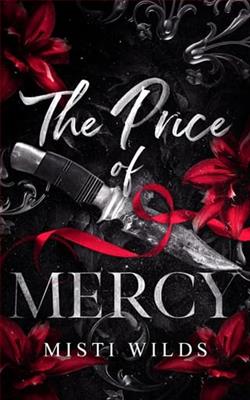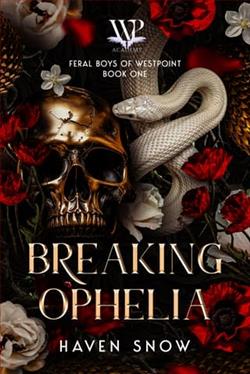Page 49 of Curse in the Quarter
They walked to the cemetery through streets where the glyph sprawl had grown eerily quiet. The oppressive weight that had settled over the Quarter all morning lifted wherever Delphine passed. Tourists moved normally again.Street performers resumed their acts. Even the usual Quarter chaos of vendors and musicians returned to its familiar rhythm.
“It’s remarkable how much calmer the area feels now,” she observed, apparently attributing the change to natural factors rather than her own influence. “Perhaps the energy required to maintain these markings was creating some kind of atmospheric disturbance.”
The Lacroix estate's private library, 1762. Rain drummed against windows while Charlotte dipped their joined fingers in red wine, using the liquid to trace symbols across parchment.
“Don't think so much,” she laughed, her hand guiding his through complex geometries. “Let your heart direct the patterns.”
“My heart knows nothing about ritual construction.”
“Your heart knows everything about love, which is the foundation of all true magic.” She completed a particularly intricate intersection, wine gleaming against paper. “When we draw these symbols, we're declaring intention. We're stating that some connections are worth preserving regardless of what forces might try to sever them.”
Her laugh was bright as bells when he struggled with a difficult transition. “You're too careful, mon ange. Magic requires commitment, not perfection.”
They worked until dawn, creating patterns that pulsed with their own inner light. By morning the wine had faded, but the memory remained burned into his consciousness—love as rebellion against cosmic law.
St. Louis Cemetery No. 1 rose before them in its familiar layout of above-ground tombs and moss-draped oaks. Spanish moss filtered afternoon sunlight into patterns that danced across marble and weathered brick. Tourgroups moved through the pathways in their usual clusters, but today their guides spoke in hushed tones, as if the weight of whatever had been building here demanded respect.
At Marie Laveau’s tomb, ash and copper symbols covered every surface in patterns so dense they created a three-dimensional mandala of interconnected meanings. Instructions for consciousness transfer, preservation of identity across death, ritual binding of souls to vessels. Advanced theoretical work that required centuries of accumulated knowledge to even attempt.
“These are consciousness transfer instructions,” Delphine said, approaching the tomb with academic fascination. “Quite sophisticated theoretical work. The kind of research Charlotte Lacroix was conducting in the 1760s, but with modern applications and understanding.”
Delphine stepped into the area. Every glyph went dark simultaneously.
Not gradual fading. Instant termination, as if she’d thrown a switch that controlled all magical energy in the cemetery. The sudden absence of pressure made nearby tourists straighten unconsciously, their bodies responding to relief from force they couldn’t identify.
“Transfer to what?” Bastien asked, documenting the deactivation while she continued her examination.
“Alternative forms of existence, I think. Ways to survive physical death while maintaining individual awareness and memory.” She paused, studying symbol combinations that would have been blazing with silver fire moments before. “The patterns suggest a gathering tonight. Midnight, specifically. When barriers between different states of existence become thinnest.”
“For what purpose?”
“Integration. Individuals with appropriate bloodline characteristics are called to participate in consciousness expansion that will complete ancestral work through voluntary participation.” She traced symbols that had gone completely inert at her touch. “It’s like a family reunion, but across multiple lifetimes.”
The stabilization effect was absolute. Children who had been crying throughout the morning stopped their tears. Adults who had felt inexplicably anxious began to relax. Even the cemetery’s cats emerged from hiding to sun themselves on tomb surfaces that had been too charged with chaotic energy to approach safely.
“We should collect samples,” Bastien said, producing evidence bags from his jacket.
He scraped ash and copper residue from several locations while she continued documentation. The materials felt wrong under his fingers, neither solid nor liquid, existing in some intermediate state that violated basic physics. They seemed to shift between textures depending on how he touched them, sometimes granular like sand, sometimes viscous like partially dried paint.
The samples began smoking the moment they were sealed in evidence bags. Not burning but releasing vapor that carried familiar scents: jasmine twisted through heated metal, the signature he’d been tracking for weeks across multiple crime scenes.
“Pattern bleed,” he said, recognizing the phenomenon from previous encounters with Charlotte’s experimental work. “Contamination that spreads through sympathetic resonance. When materials connected to the same working come into proximity, they strengthen each other exponentially.”
“The samples are reacting to something nearby?”
“Something that shares origin with the glyphs. An artifact or person whose essence is compatible with the magical network.” He studied her face carefully, noting no recognition of her role in the phenomenon. “The reaction suggests we’re very close to whatever focal point organizes these manifestations.”
The evidence bags blazed silver, then went dark. Their contents consumed entirely, leaving only scorch marks that formed symbols matching the deactivated glyphs. Even the plastic had been transformed, bearing patterns that seemed to have been burned from the inside out.
“Direct material connection,” Delphine said, documenting the scorched containers with her camera. “Whoever is orchestrating these manifestations has access to the same historical sources we’ve been researching. They’re not just copying Charlotte Lacroix’s work; they’re continuing it.”
“Or they’re the source,” Bastien said quietly.
She turned to face him, expression sharp with intellectual curiosity. “Meaning?”
“Some families involved in colonial-era experiments may have preserved more than just techniques and documentation. They may have preserved consciousness itself, passed through bloodline inheritance across generations.” He watched her carefully for any sign of recognition. “The person we’re looking for might not be using Charlotte Lacroix’s work. They mightbeCharlotte Lacroix.”
Delphine studied the deactivated glyphs surrounding them, pieces of a puzzle larger than either of them had initially realized. When she spoke, her voice carried the weight of someone processing implications that challenged everything she thought she knew about the nature of reality and identity.















